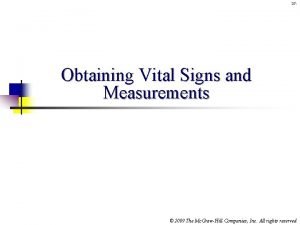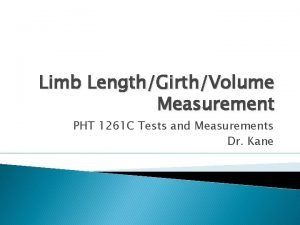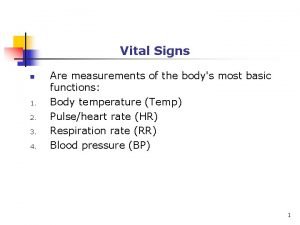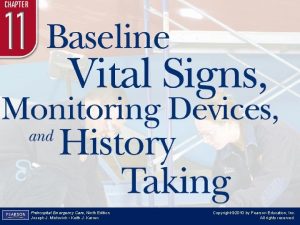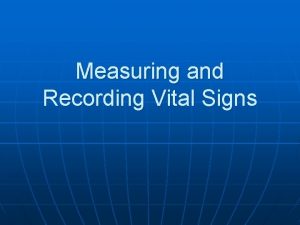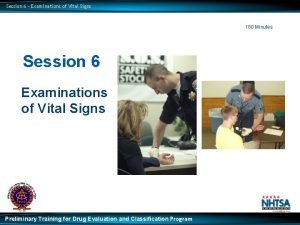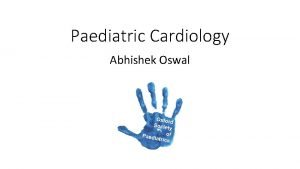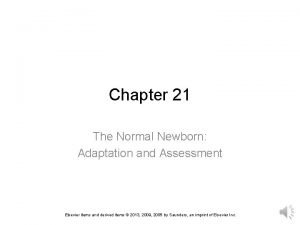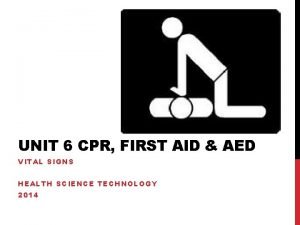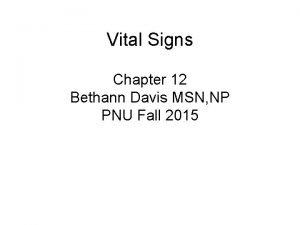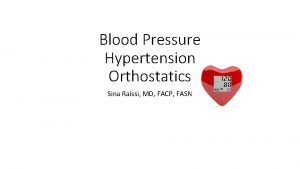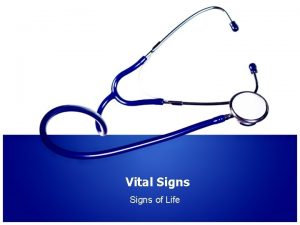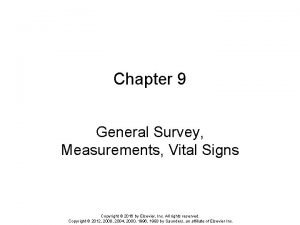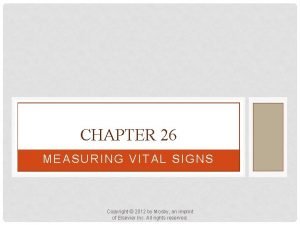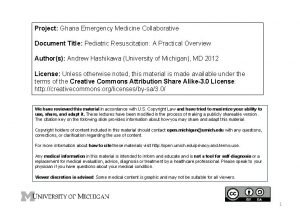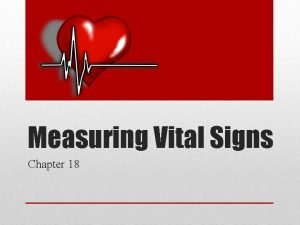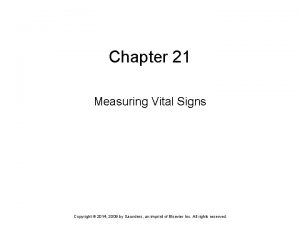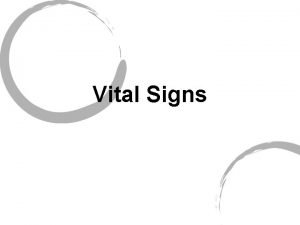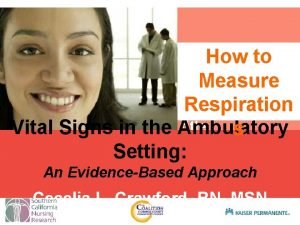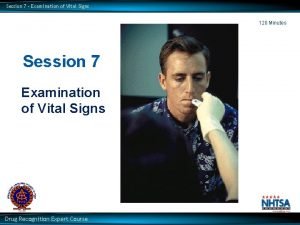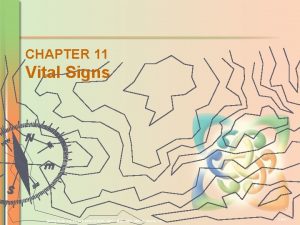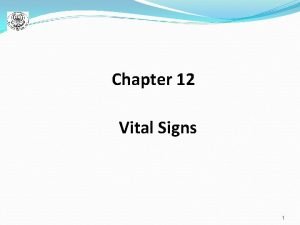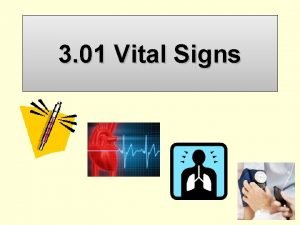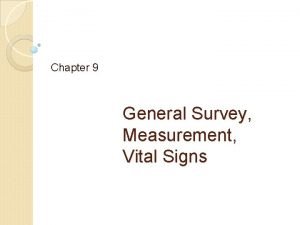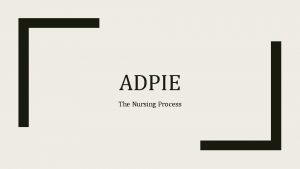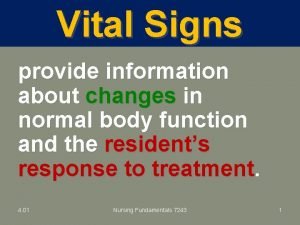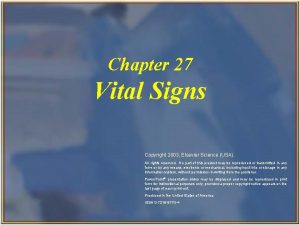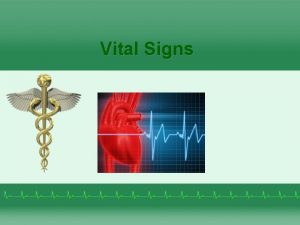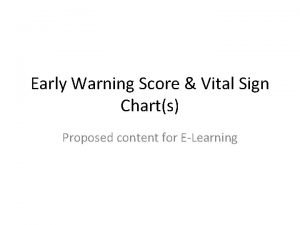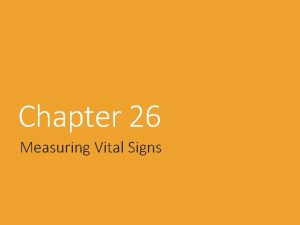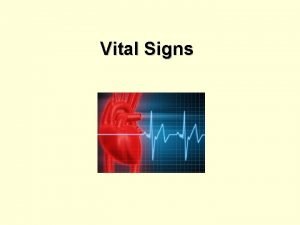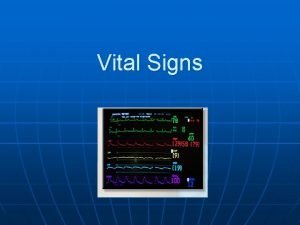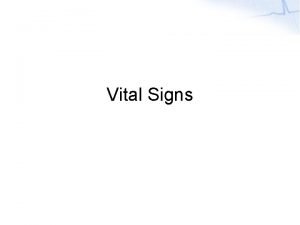Vital signs Anthropometric Measurements Dr Jennifer Lucy Vital




























































- Slides: 60

Vital signs/ Anthropometric Measurements Dr. Jennifer Lucy

Vital signs are physical signs that indicate an individual is alive Includes heart beat, respiratory rate, temperature, blood pressures and recently oxygen saturation.

Vital sign Signs may be observed, measured, and monitored Assess an individual's level of physical functioning.

Vital sign Before measurements, patient should sit for five minutes.

Observation Does the patient seem anxious, in pain, upset? Remember, anxiety can affect vital sign results

Temperature Vital signs

Temperature Babies and young children tend to have higher temperatures Elderly clients tend to have lower, hence a 97. 9 might be a fever.

Temperature Body temperature of affected by Gender Recent activity Food and fluid consumption Menstrual cycle.

Normal Temperature Fahrenheit/Celcius Normal Range: 97. 8 F – 99 F equivalent to 36. 5 C 37. 2 C

Oral ( do not take Converting F to C after food or -30 then divide by 2 smoking for 30 mins C to F Place probe under x 2 + 30 tongue Second most accurate route after rectal

Temperature ( Rectal ) Rectal temperatures tend to be 1° higher than when taken by mouth. Position patient in Sims ( left side lying position Insert probe 1 inch for patients over 6 months old ½ inch for under patients under 6 months old

Temperature ( Axillary) Axillary temperatures can be taken under the arm. Temperatures taken by this route tend to be 0. 3 to 0. 4° (Fahrenheit) lower than those temperatures taken by mouth.

Tympanic ( Aural) Measure’s body's core temperature For patients over 3 years gently pull pinna up and out For under three years gently pull pinna down and back.

Temporal Measures infrared heatwaves across skin of forehead

Fever A fever is indicated when body temperature rises above 99. 0 orally or 99. 8° F rectally.

Hypothermia/ Hyperthermia Hypothermia is defined as a drop in body temperature below 96° F. Hyperthermia is defined as a rise in body temperature above 104 F.

Respiratory rates Vital signs

What is the respiratory rate? The respiration rate is the number of breaths a person takes per minute.

Respiratory Rate Try to do this as surreptitiously as possible. Observing the rise and fall of the patient's hospital gown while you appear to be taking their pulse.

Respiratory Rate • Breaths should be counted for at 30 second then times by 2 if regular Count for one minute if irregular

Respiratory Rate Respiration rates may increase with fever , illness or pain

Respiratory Rate Normal respiration rates at rest range from 12 to 20 breaths per minute. 12 20

Abnormal Respiratory Rate Bradypnea under 12 breaths per minute Tachypnea over 20 breaths per minute under 12 breaths over 20 breaths

Pulse Vital signs

Pulse rate The normal pulse for healthy adults ranges from 60 to 100 beats per minute.

Pulse rate The pulse rate may fluctuate and increase with exercise, illness, injury, and emotions. Girls ages 12 and older and women, in general, tend to have faster heart rates than do boys and men.

Pulse rate Athletes, such as runners, may have heart rates in the 50's and experience no problems.

Radial pulse You feel the beats by firmly pressing on the arteries, which are located close to the surface of the skin at certain points of the body.

How to check your carotid pulse The carotid pulse can be found on the side of the lower neck, .

Pulse: Quantity Measure the rate of Regular Pulse the pulse (recorded in beats per minute). Count for 30 seconds and multiply by 2 (or 15 seconds x 4) Measure for a full Irregular minute

Pulse: Regularity Is the time between beats constant? . Irregular rhythms, are quite common.

Brady / Tachycardia Below 60: Bradycardia Above 100: Tachycardia

Average Heart rate by Age New born 120 -160 bpm Infant ( 1 to 12 months) 80 -140 bpm Toddler (1 -3 years) 80 -130 bpm Preschool (3 -5 -years )80 -120 bpm School age ( 6 -15) 70 -100 bpm Adult ( over 15 years) 60 -100 bpm

Blood pressure Vital signs

Preparation for measurement Patient should abstain from eating, drinking, smoking and taking drugs that affect the blood pressure 30 mins before measurement.

Position of the Patient Sitting position Arm and back are supported. Feet should be resting firmly on the floor Feet not dangling.

Equipment needed to measure blood pressure Adult Cuff size – Indications for large cuff or thigh cuff Upper arm circumference >34 cm – Indications forearm cuff (with radial palpation) Upper arm circumference >50 cm

Blood Pressure If cuff is too small, the readings will be artificially elevated. The opposite occurs if the cuff is too large. Clinics should have at least 2 cuff sizes available, normal and large.

Cuff position Patient's arm slightly flexed at elbow Push the sleeve up, wrap the cuff around the bare arm

In order to measure the Blood Pressure (Cuff Position) Cuff applied directly over skin (Clothes artificially raises blood pressure ) Position lower cuff border about 2 inches above antecubital Center inflatable bladder over brachial artery

What Abnormal Results Mean

Blood pressure for adult Physician will want to see multiple blood pressure measurements over several days or weeks before making a diagnosis of hypertension and initiating treatment.

Blood pressure (mm Hg) Normal blood pressure Systolic 100 to 119 Diastolic 60 to 79 Pre hypertension Systolic 120 to 139 Diastolic 80 to 89

Hypertension High blood pressure greater than 139 -89. .

Hypertension Stages STAGE ONE ( Primary) Systolic 140 -159 Diastolic 90 -99 STAGE TWO Systolic 160 or higher Diastolic 100 or higher

Hypertensive Crisis Systolic 180 or above Diastolic 110 or above

Hypotensive stage Systolic less than 90 Diastolic less than 60

Blood pressure may be affected by many different conditions Cardiovascular disorders Neurological conditions Kidney and urological disorders

Blood pressure may be affected by many different conditions Preclampsia in pregnant women Psychological factors such as stress, anger, or fear Eclampsia

PALPABLE B/P Feel for radial pulse Inflate cuff Feel when pulse is no longer palpable Add 30 That is your starting point when you do B/P

Oxygen Saturation Vital signs

Oxygen Saturation provides important information about oxygen perfusion Normal levels 90 -100% Make sure patient has no nail polish on Make sure hand is flat on table Capillary refill should be less than 3 seconds.

Height Procedure Place paper towel on scale Place scale at Zero Point Remove shoes Stand straight Measure client Convert 5 feet 6 inches to inches 5 ft x 12=60 inches +6=66 inches x 2. 54= 167. 64 cm

Weight Place paper towel on scale Place scale on zero Guide client onto scale Read scale Convert weight from lbs to kg by multiplying pounds by 0. 45 140 lbx 0. 45=63 kg. For kg to pounds Multiply kg by 2. 2 83 kgx 2. 2=183 lb

Pediatric Anthropometric Measurement Birth to 3 years Head Circumference Lay baby on back in supine position Zero mark is placed at forehead. Bring around head just above the ears Length Gently extend leg Measure length from head to foot Weight Set scale Remove diaper Place in middle of scale

Body Mass Index Take height and weight Calculate BMI Values Normal 18. 5 -24. 9 Underweight<18. 5 Overweight>25 -29. 9 Obese>30

Pain Scale 0 – Pain free. Mild Pain – Nagging, annoying, but doesn't really interfere with daily living activities. 1 – Pain is very mild, barely noticeable. Most of the time you don't think about it. 2 – Minor pain. Annoying and may have occasional stronger twinges. 3 – Pain is noticeable and distracting, however, you can get used to it and adapt. Moderate Pain – Interferes significantly with daily living activities. 4 – Moderate pain. If you are deeply involved in an activity, it can be ignored for a period of time, but is still distracting. 5 – Moderately strong pain. It can't be ignored for more than a few minutes, but with effort you still can manage to work or participate in some social activities. 6 – Moderately strong pain that interferes with normal daily activities. Difficulty concentrating.

Severe Pain – Disabling; unable to perform daily living activities. 7 – Severe pain that dominates your senses and significantly limits your ability to perform normal daily activities or maintain social relationships. Interferes with sleep. 8 – Intense pain. Physical activity is severely limited. Conversing requires great effort. 9 – Excruciating pain. Unable to converse. Crying out and/or moaning uncontrollably. 10 – Unspeakable pain. Bedridden and possibly delirious. Very few people will ever experience this level of pain.

Pain scale pictures

 Anthropometric measurement includes vital signs
Anthropometric measurement includes vital signs Dr lucy jennifer
Dr lucy jennifer Degree of malnutrition formula
Degree of malnutrition formula Chapter 37 vital signs and measurements
Chapter 37 vital signs and measurements 8 vital signs
8 vital signs All traffic signs and meanings
All traffic signs and meanings Md solarscience
Md solarscience L
L Popliteal length
Popliteal length Anthropometric assessment
Anthropometric assessment Volúmenes pulmonares
Volúmenes pulmonares Conclusion on vital signs
Conclusion on vital signs Chapter 15:6 measuring and recording apical pulse
Chapter 15:6 measuring and recording apical pulse Introduction of vital signs
Introduction of vital signs Test chapter 16 vital signs
Test chapter 16 vital signs Baseline vital signs
Baseline vital signs Chapter 16:7 reading an aneroid sphygmomanometer
Chapter 16:7 reading an aneroid sphygmomanometer Normal vital signs for all age groups
Normal vital signs for all age groups Tpr/bp/vitals chart
Tpr/bp/vitals chart Measuring and recording vital signs
Measuring and recording vital signs 6 vital signs
6 vital signs Guidelines for measuring vital signs
Guidelines for measuring vital signs Tetralogy of fallot murmur
Tetralogy of fallot murmur Vital signs height and weight
Vital signs height and weight Elsevier
Elsevier Orthostatic vitals definition
Orthostatic vitals definition Vital signs normal range
Vital signs normal range 6 vital signs first aid
6 vital signs first aid Msn signs
Msn signs Normal vital signs
Normal vital signs Where is apical pulse
Where is apical pulse Aquamatic k pad
Aquamatic k pad Orthostatic vitals positive
Orthostatic vitals positive What are the 7 vital signs
What are the 7 vital signs Orthostatic vitals
Orthostatic vitals Chapter 26 measuring vital signs
Chapter 26 measuring vital signs Vital chart
Vital chart Respiratory number 18
Respiratory number 18 Conclusion of vital signs
Conclusion of vital signs 5 vital signs
5 vital signs Fundamentals of nursing chapter 17 vital signs
Fundamentals of nursing chapter 17 vital signs Measuring vital signs chapter 21
Measuring vital signs chapter 21 Vital sign
Vital sign Normal respiratory rate
Normal respiratory rate Vital signs
Vital signs Chapter 14:7 measuring and recording blood pressure
Chapter 14:7 measuring and recording blood pressure Summary of vital signs
Summary of vital signs Chapter 11 vital signs
Chapter 11 vital signs Vitals by age
Vitals by age Regular vital signs
Regular vital signs Blood pressure child normal range
Blood pressure child normal range Orthostatic vitals definition
Orthostatic vitals definition What does adpie stand for
What does adpie stand for Vital signs normal range pediatrics
Vital signs normal range pediatrics Side of pulse
Side of pulse Purpose of vital signs
Purpose of vital signs Normal range for vital signs
Normal range for vital signs Chapter 27 vital signs
Chapter 27 vital signs Vital signs chart
Vital signs chart Normal level of vital signs
Normal level of vital signs Mews score meaning
Mews score meaning




